Winnipeg Jets head coach Rick Bowness announced his retirement on Monday. Bowness was Winnipeg's coach for these last two seasons, leading them to the playoffs twice. He had a Cup Final run with Dallas in the 2020 Bubble Playoffs but was never able to lift the Stanley Cup. Regardless, he seems to be held in high esteem by a lot of people in the game and, as a fellow New Brunswicker, it's always nice to see someone from this area of the country succeed at that level. All the best to him and his family in his retirement.
*
Some rare positive postseason injury news, this time for New York's Blake Wheeler:
Wheeler was injured in February, and it looked as if his season was over, playoffs or not. With the team playing the way they are, and Filip Chytil a potential returnee himself, it'll be interesting to see if Wheeler gets into the lineup even if he's 100% cleared. That may not necessarily be the case.
*
Detroit signed prospect defenceman Axel Sandin-Pellikka to his entry-level deal. He just finished a successful season in Sweden and the first-round pick from 2023 is now on his way to North America. He is likely to spend a season in the AHL as Detroit has six defencemen signed for 2024-25 and that doesn't include Simon Edvinsson, who was a staple in the lineup late in the season.
*
The New Jersey Devils have signed defenceman Seamus Casey to his entry-level contract, per Amanda Stein. Casey was drafted in the second round of the 2022 Draft and spent the last two seasons playing college hockey for the powerhouse Michigan team. He had a couple of very good seasons for the Wolverines and is now set to become part of the Devils' system.
There probably should be patience exercised as far as fantasy hockey value is concerned. Both Dougie Hamilton and Jonas Siegenthaler have four years left on their contracts, John Marino has three, and both Luke Hughes and Simon Nemec are far ahead of Casey on the NHL depth chart. It seems likely Casey spends at least one year in the AHL, maybe getting a call-up here and there. It is another future piece to the New Jersey blue line being added to the system, though, as they keep building a lot of young defensive depth.
*
The New Jersey Devils have signed defenceman Seamus Casey to his entry-level contract, per Amanda Stein. Casey was drafted in the second round of the 2022 Draft and spent the last two seasons playing college hockey for the powerhouse Michigan team. He had a couple of very good seasons for the Wolverines and is now set to become part of the Devils' system.
There probably should be patience exercised as far as fantasy hockey value is concerned. Both Dougie Hamilton and Jonas Siegenthaler have four years left on their contracts, John Marino has three, and both Luke Hughes and Simon Nemec are far ahead of Casey on the NHL depth chart. It seems likely Casey spends at least one year in the AHL, maybe getting a call-up here and there. It is another future piece to the New Jersey blue line being added to the system, though, as they keep building a lot of young defensive depth.
*
The Dobber Hockey crew has submitted their second-round picks (they were submitted before Game 1 between New York and Carolina, actually). Yours truly went 6-for-8 in the first round with losses from Toronto (I should have known better) and Winnipeg (still processing what a beatdown that was). My second-round picks are Carolina in 7, Florida in 6, Dallas in 6, and Edmonton in 6.
I really don't feel great about Carolina. They didn't really throttle the Islanders and were clearly a step behind the Rangers in Game 1. It should be a fun series, at any rate.
*
Speaking of the second round, Game 1 between Boston and Florida went to the Bruins as they managed a 5-1 win over the Panthers. Jeremy Swayman was absolutely tremendous with 38 saves on 39 shots to hold Florida largely at bay, and give his team a chance to build a lead they would never surrender.
Boston's secondary scoring came through in a big way as Morgan Geekie, Mason Lohrei, and Brandon Carlo all scored in the second period to give Boston a 3-1 lead, and Justin Brazeau and Jake DeBrusk (EN) capped things off in the third period.
Lohrei ended the game with a goal, an assist, two shots, two blocks, and four hits in a stat-stuffing night. Carlo had the lone goal on two shots with three blocks and six hits.
Matthew Tkachuk tallied Florida's only goal, posting five total shots and six hits.
Game 2 is Wednesday night.
*
My offseason review of the 16 non-playoff teams continues. We have already gone over the San Jose Sharks, the Chicago Blackhawks, the Anaheim Ducks, the Columbus Blue Jackets, and the Montreal Canadiens. Moving up one rung, we are now breaking down The Artists Formerly Known As The Arizona Coyotes. Let's review what went wrong, what went right, and where they go from here.
Data from Natural Stat Trick, Evolving Hockey, HockeyViz, and Frozen Tools with salary cap data from Cap Friendly. Any tracking data is from AllThreeZones unless otherwise noted.
What Went Wrong
We have to start at the top of the lineup with Clayton Keller and Nick Schmaltz. Over the two seasons from 2021-2023, they averaged 2.47 and 2.54 points per 60 minutes at even strength, respectively; in 2023-24, those numbers fell to 2.02 and 1.68, respectively. Schmaltz was particularly hit hard as he produced 60.2 even strength points per 79 games from 2021-2023 but landed with 39 EV points in 79 games this season. That is a per-game drop of nearly 17%, and that's huge.
Like most things, there was more than one cause. The first is that the team, generally speaking, focused a lot more on seam passes from their forwards; in 2022-23, the team's 5-on-5 tracking data had them with 10.2% of passes leading to shots being seam passes. In 2023-24, that spiked to 18.9%, or a relative increase of a whopping 85%. Most of those passes came off the sticks of Keller and Schmaltz, which makes the shot map from 2023-24 look like this:
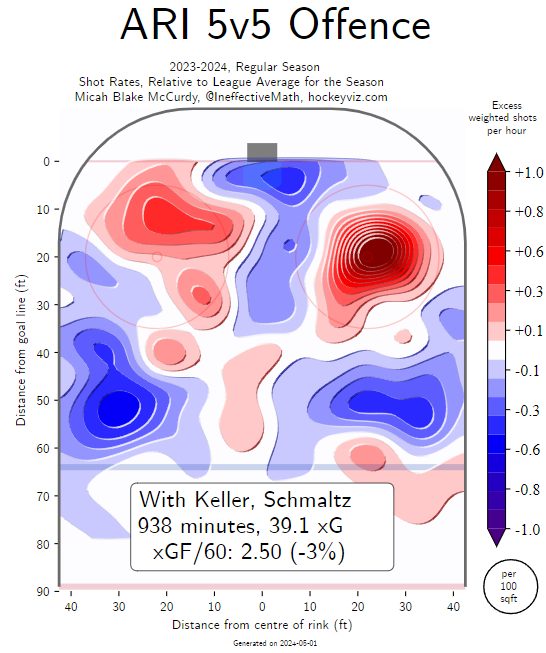
Those red blotches in the circles are the result of those kinds of passes. It stands in contrast to 2022-23 where they did some of that, but also got to the net a good amount as well:

When this approach works well – think this season's New York Rangers and specifically the Artemi Panarin line – it can lead to a lot of easy-ish goals. If it doesn't, you get the 2021-22 Montreal Canadiens top line, or this season's Coyotes top line.
The curious part is Schmaltz found a lot of success in the slot/net-front area in from 2021-2023. He scored 20 of his 31 goals at 5-on-5 from below the hash marks and between the dots; he scored 5 of 7 such goals in that manner this season, too. So that he adopted another attacking style didn't seem to fit him all that well.
Schmaltz shot 6.5% at 5-on-5, a steep decline from the 14.4% across 178 games of the three preceding seasons, so there will be positive regression there. Maybe things improve if Logan Cooley takes a step forward and shows himself to be a better offensive centre than Barrett Hayton, but time will tell.
Keller had kind of the same problem, just not to the same degree, and what hurt Keller's production more than anything was Schmaltz (and whichever centre they had) not finishing the chances: Keller's three-year average of primary assists at 5-on-5 was 0.85 per 60 minutes, and that fell to 0.68 in 2023-24. The 5-on-5 goal scoring dropped as well (0.99 per 60 minutes) but was nearly in line with the three prior seasons (1.03). The lack of 5-on-5 assists hurt his total so if Schmaltz's shooting percentage rebounds, Keller's assist rates should as well.
It was a bad year for Hayton and while most of that can be chalked up to the hand injury that plagued him from mid-November onward, he also had a tough start to the year. He had zero points in the team's first 11 games of the season, and had three points in 15 games before being injured. The worrisome part is Hayton was basically stapled to Keller for those 15 games, skating roughly 90% of his even strength time next to the talented winger, plus consistent top power play minutes. Those 15 healthy games skating almost exclusively with Keller resulted in a shot attempt rate of 11.8 per 60 minutes, or a 34th percentile mark. He doesn't hit, he doesn't shoot much, and the team has Cooley ascending. Hayton's days as a top line/top power play option may be numbered. The team may give Hayton one more chance at the start of the 2024-25 season, but he's not going to have a long leash. He looks to be a solid two-way, middle-six centre in real life, but that real-life value may not translate well to fantasy.
Connor Ingram had a very up-and-down campaign. At the All-Star break, he had 17 wins in 30 starts with a .917 save percentage. The now-Utah franchise was within five points of a playoff spot with one game in hand on St. Louis and three games in hand on Nashville. After the All-Star break, he won just 6 of 18 starts with a save percentage of .890. At one point, he went 45 days between wins.
From a fantasy standpoint, it's hard to say anything went wrong with Ingram as he won 23/48 starts in 2023-24 compared to a win ratio of 6/26 from the year prior. He wound up with a .907 save percentage, the same as the year before and in a league where the average save percentage dropped a point. Better defence from Arizona also resulted in fewer shots, so Ingram's goals against rate dropped from 3.37 to 2.91. This was a goalie whose ADP was around or lower than the 25th goalie off the board in a lot of formats and was a top-15 goalie in standard Yahoo! leagues and top-20 in ESPN points formats. It is hard not to think of what could have been had he stayed consistent in the second half, though.
Part of Ingram's problem was Arizona's penalty kill. They allowed the fourth-most shots against per minute while short-handed and gave up the sixth-most goals against. Combine that with the fifth-most power play opportunities given to the opponent per game and Ingram was 28th out of 33 goalies by goals against rate on the penalty kill. The team gave up way too much from the circles and the net-front area:
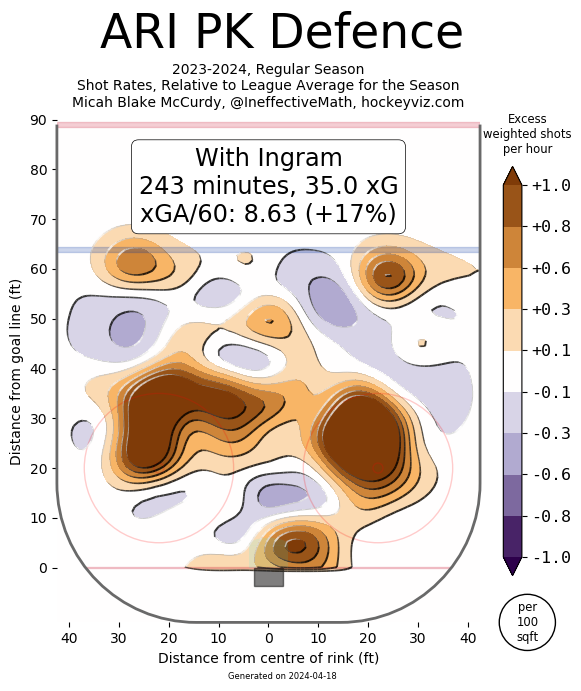
The 27-year-old netminder could be better on the PK himself, but he was not the problem in and of itself. Like Sam Montembeault in Montreal, Ingram is now at least in a time share, which is good for his start totals, but it will be hard to take the next step in fantasy value until that PK improves, the team becomes more disciplined, or (hopefully) both.
What Went Right
Despite the drop in even strength scoring from Keller and Schmaltz, there were power play improvements and that's very good news. Keller's rate of 7.0 points per 60 minutes with the man advantage was *by far* a career-high, exceeding his rate from 2019-20 by nearly 59%. Schmaltz also had a career-high rate of 4.93, slightly higher than the 2019-20 rate, and a 28% improvement from last season.
A big reason for Keller's PP point rise was his involvement, as he got in on 83.3% of Arizona's PP goals scored with him on the ice. He hadn't been above 67% for three straight years, so there is concern in that regard. However, there were improvements under the hood that could support that jump, so let's look at that quickly.
From 2020-2023, Keller shot 13.5% on the power play. In 2023-24, that conversion rate was 15.8% which isn't very far off from that three-year average and was basically in the middle of the league among forwards with at least 200 power play minutes. He was also 1 of 8 forwards to take between 24-27% of his team's PP shot attempts while shooting at least 15%. Half of those forwards were in on at least 79% of the team's PP goals:

Keller taking more shots overall, and more of his team's shots, is probably a reflection of Jakob Chychrun and Shayne Gostisbehere being traded late in the 2022-23 season. Their shot attempt rates (30.6 and 24.0, respectively) last year were much higher than Sean Durzi's (20.9) or JJ Moser's (10.7) this year. The team took more shots, Keller did as well, and that helped both his goal and assist rates on the power play. Repeating 83% of goal involvement will be hard, but if the team's PP can just keep improving overall, there's no reason he can't put up at least 25 power play points again.
Like Ingram, it was a tale of two seasons for Cooley. He had a tough start to the year, but things really took off once Dylan Guenther was called up in January. Here are Cooley's improvements at 5-on-5, including some tracking data, looking before January 7th (Guenther's call-up date) and after:
| Before January 7 | After January 7 | |
| Shot Attempts/60 | 9.2 | 13.9 |
| Points/60 | 1.03 | 1.83 |
| Individual Expected Goals/60 | 0.55 | 0.71 |
| Chance Assists/60 | 1.56 | 4.22 |
| Rush Contributions/60 | 8.86 | 12.14 |
| Carry-In Zone Entries/60 | 11.46 | 18.48 |
It was across-the-board improvements and while there are more games to track, the team took 21% more shots with Cooley on the ice with Guenther than without him. Those two made a very good duo down in the second half so while the fantasy season for Cooley wasn't a resounding success overall, he still had 44 points in 82 games as a rookie and got stronger as the year went on. If he can keep improving individually, and earn those top PP minutes with Keller, Schmaltz, Guenther, and Durzi, there is a lot more production to come, and probably as soon as 2024-25.
Guenther was pretty good in his own right and made a difference on the power play; the top PP unit generated nearly 15% more shot attempts with Guenther than without him. The goal rate went down, but it's largely because they were riding hot before he got there, shooting over 20% (for reference, Tampa Bay shot 18.7% with Nikita Kucherov on ice for the power play, so over 20% is far too high).
While he succeeded on the power play, Guenther also led the team's forwards in shots off the rush at 5-on-5 with 6.9 per 60 minutes. The league average was 3.6/60, and here is where Guenther ranked among forwards with at least his number of minutes tracked:

We need a bigger sample before making any determinations, but it's certainly a step in the right direction, and jives with the improvements Cooley made in the second half.
Like others on the roster, it was two different seasons for Durzi. He had 28 points in 42 games heading into the All-Star break and was on his way to a 50-point season. That production fell off hard in the second half with 13 points in 34 games. He finished the season with four points in four games, so the stretch from the All-Star break to April 10th saw him post nine points (and zero goals) in 30 games. Those in head-to-head fantasy leagues already know this all too well.
The reasons were numerous.
First was a drop in his involvement in the team's PP goals – he went from a 45.6% involvement rate to 37.5%. That coincided with a rise from Keller, so with fewer PP goals scored with them on the ice, and Keller's involvement rising, Durzi's production suffered.
That drop in goal involvement was mirrored at 5-on-5 as he went from nearly 40% to 22.2% in the second half. In those splits, he factored in on 28.9% of Arizona's total goals scored with him on the ice in the second half, a sharp drop from the 41.2% in the first half. Overall, he finished at 36.3%, or roughly the middle of the league.
It is interesting to see Durzi drop that much. The second half saw Guenther added to the lineup with Cooley taking off. Random variance is involved, but with more talent up front, he went from a 5.5 carry-in zone entry rate per 60 minutes in the first half to a rate of 3.8/60 in the second half. He was less involved in transition, deferring to the forwards, and it hurt his points rate. Something to keep in mind for 2024-25.
It was another good year for both Lawson Crouse and Matias Maccelli. The former had his third straight season with at least 20 goals and 2.0 hits per game while the latter doubled his shots per game. Maccelli's per-game went down slightly, but it was another productive season and if he's a genuine 20-goal threat now, it changes his fantasy profile. A lack of top power play time, assuming that's the case in 2024-25, is the big concern for his fantasy value.
Where They Go From Here
I have said it before, but it really sucks for Coyotes fans that the team was relocated at this point in time. They missed the playoffs again but between Keller, Schmaltz, Cooley, Guenther, Maccelli, and Crouse, they now have two genuine scoring lines. Durzi had a good year and is every bit the top-4/top PP blue liner he showed promise of back in Los Angeles. Ingram had a tough second half but the defence was not very good and better penalty killing will make his numbers look a lot better. That is a good core to start with and they have prospects like Daniil But, Dmitry Simashev, Conor Geekie, and Maveric Lamoureux on the way. This team may only be a couple years from being a true playoff contender.
This will be a fascinating summer from the new Utah franchise. None of their defencemen are currently signed for 2024-25, which means new contracts for Durzi, Moser, Juuso Välimäki, and probably Josh Brown. How long those contracts are, and for how much, remains to be seen, but it shouldn't be less than $15M combined by AAV, supposing at least Durzi and Moser get long-term deals.
There is also an extension necessary for Hayton, though he probably gets a bridge deal. Almost regardless of what kind of contract he gets, the team could have those four defencemen signed, plus Hayton, and still have in the neighbourhood of $30M in cap space. That is with 11 forwards, four defencemen, and two netminders signed. They have more than enough space to sign a key free agent, particularly on the blue line. They also have 10 (!) second-round picks over the next three years, so there is lots of draft and prospect capital to make a trade for a big-name RFA. With a new owner in a new location, they may want to make a splash to push this team towards the playoffs. They have all the assets necessary to do just that.
It is hard not to be bullish on this team. There is still some distance to go before they're in the Dallas/Colorado/Edmonton tier of teams in the West, but it is not far for them to catch the likes of Los Angeles, Nashville, St. Louis, or Minnesota. They should be even better offensively, which is what we want to see for fantasy purposes. Improved defence could easily make Ingram a top-15 fantasy goalie as well, so there is lots of goodness to look forward to. The next 12 weeks are pivotal ones for the future of this franchise, and it's exciting to think of what the roster will look like come training camp.


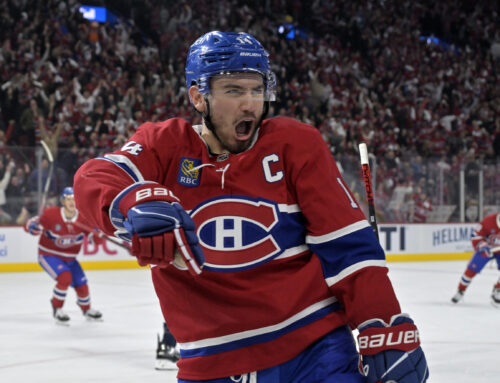
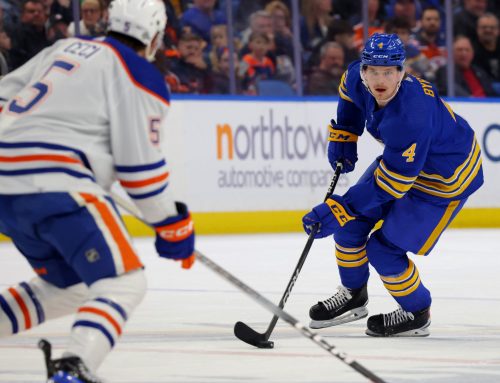
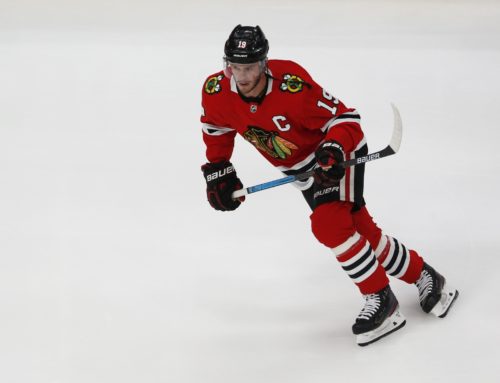
 PHI
PHI ANA
ANA VAN
VAN DET
DET BUF
BUF NYR
NYR MIN
MIN
